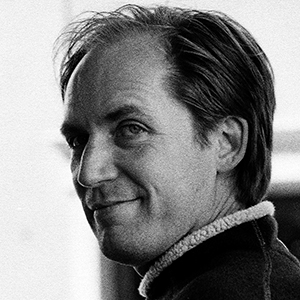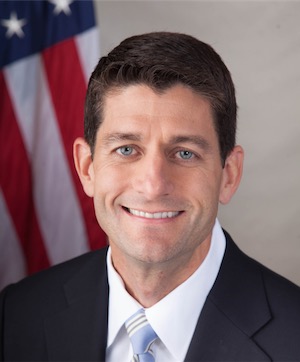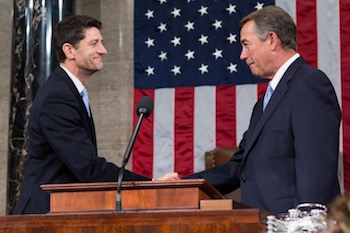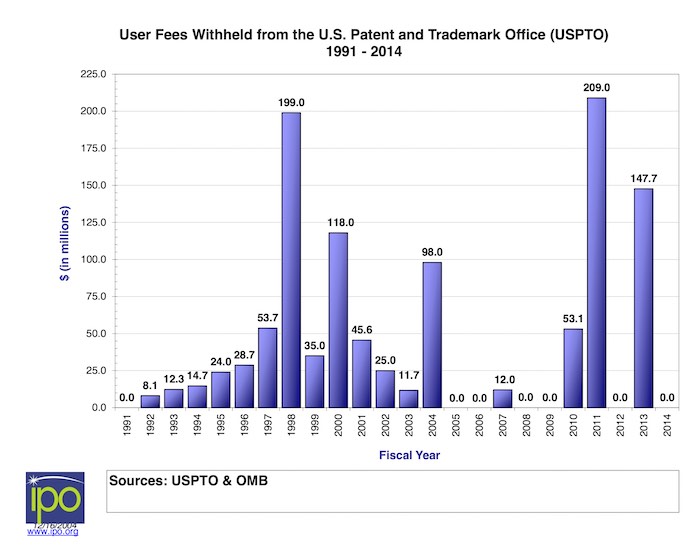April 5, 2016, looms large for the GOP. That is the date Wisconsin will hold its primary, after which we may know whether it is likely (or virtually impossible) for Republican frontrunner Donald Trump to amass a majority of delegates heading into the convention in July.
Speaker Paul Ryan is enduring much stress as a result. Candidates Donald Trump, Senator Ted Cruz, and Governor John Kasich stomp through his home Wisconsin, increasing scrutiny of Ryan’s political abilities. Also, Wisconsin political figures like Governor Scott Walker, a former presidential primary contender himself, are back in the national news. Even the Senate race in Wisconsin is getting more consideration. Former Senator Russ Feingold (D) is challenging incumbent Ron Johnson (R) and may be benefiting from the speculation that if Trump is the GOP nominee many Republicans will stay home in November, which could result in Republicans losing their majorities in the Senate and or the House.
There has been a nearly a two-week gap between primaries, enabling abnormal scrutiny on Wisconsin. And let’s not forget that Reince Priebus, Chairman of the Republican National Committee (RNC), is from Wisconsin and with Walker and Ryan have tried to make the Badger State a more prominent player in national political trends and perspectives.
This extra attention on Wisconsin, coupled with Paul Ryan being the dream candidate for those who favor an open Republican Convention, provides us with a somewhat manufactured, yet novel and non-obvious opportunity to examine Ryan’s views on patents. Oddly, much like those of candidate Kasich, Ryan’s views have been in favor of fee diversion, which have been identified by former heads of the U.S. Patent & Trademark Office as the single biggest problem that has or will face the Office.
We’ve previously covered the relatively pro-patent views of former Governor and presidential candidate Mitt Romney (with political and family ties spanning Utah, Michigan and Massachusetts), who is also considered a draft candidate possibility if there is an open Republican convention. Ryan was his running mate in 2012. While Ryan did vote for the Leahy-Smith America Invents Act in June 2011, which President Barrack Obama signed into law in October 2011, Ryan did so at some cost with his own Wisconsin constituents. (In 2012 Obama beat Romney-Ryan in Wisconsin.)
Many in Wisconsin agree with Romney on patents and may, in fact, wish to repudiate Ryan now as Speaker as he confronts his colleagues in the Freedom Caucus and elsewhere in the GOP that voted against the AIA outright or voted for it with hesitation and now have buyer’s remorse. The Freedom Caucus helped move John Boehner (R-OH) out of the Speaker’s office and into retirement and many in the Freedom Caucus have fought against H.R.9, The Innovation Act, the current patent litigation abuse reform bill pending in the House.
Conservatives are champions of the Constitution and private property rights, including patent rights, and at least one member of the House Freedom Caucus is a successful, patented inventor – Congressman Thomas Massie (R-KY). Many other conservatives have openly questioned H.R. 9 and its companion in the Senate, S. 1137, the PATENT Act. Presidential candidate Senator Ted Cruz (R-TX), for example, voted against S. 1137 during the Judiciary Committee markup last year citing concerns that the bill would harm small innovators simply trying to assert rights protected by the Constitution (see here, here and here). And on March 29, 2016 Wisconsin Governor Scott Walker endorsed Cruz. Former Ohio Secretary of State Ken Blackwell has openly discussed the cronyism of patent reform. Former HP CEO and presidential candidate Carly Fiorina and former Senator and candidate Rick Santorum (R-PA) have made similar comments (see here and here, respectively).
Ryan’s oddity on patents, however, inadvertently served the people of Wisconsin albeit temporarily by blocking the America Invents Act with a poison pill. As then Chairman of the House Budget Committee, Ryan worked with Congressman Hal Rogers (R-KY), then Chairman of Appropriations, to freeze patent reform even after a very strong bi-partisan Senate vote in March 2011. Ryan and Rogers passionately felt that the Senate bill would not allow Congressional oversight of the USPTO budget and thus the conduct of the patent office. See House Republicans Oppose Adequately Funded Patent Office. Their objection was simple: The Senate bill would have ended fee diversion.
It is at least somewhat ironic that Ryan took this position given he had only become Chairman in 2011 after the Tea Party wave of 2010 helped Republicans regain their majority in the House, which was lost in 2006. The Tea Party rallied America to reduce the size and cronyism of big government and against the backdrop of the bailouts of banks and the expansion of government under the Affordable Care Act (ACA), otherwise known as Obamacare. Newly in power, Ryan appeared to side with long-time Members such as Rogers who believe all federal spending must pass through the appropriations process even for an agency that is fully funded by user fees.
Congressmen Ryan and Rogers specifically wrote:
We strongly oppose this proposed shift of billions in discretionary funding and fee collections to mandatory spending. Putting the PTO funding on auto-pilot is a move in exactly the wrong direction, given the new Republican majority’s commitment to restraining spending, improving accountability and transparency, and reducing the nation’s unparalleled deficits and debt.
Placing PTO spending on mandatory auto-pilot as outlined in H.R. 1249 would also hand Congressional “power of the purse” — bestowed in the Constitution — to the Obama White House, and essential eliminate the ability of Congress to perform substantive oversight of the PTO.
S.23 passed the Senate with 95 votes after Senator Patrick Leahy (D-VT) added a Manager’s Amendment at the start of the floor debate to end fee diversion. During debate in the Judiciary Committee in the years leading up to the final floor vote and committee markup only a few Senators such Dick Durbin (D-IL) and Barbara Mikulski (D-MD) occasionally expressed concern about interference in the Appropriations process. Their words and letters paled in comparison to the pressure applied by the Ryan and Rogers campaign.
Ryan and Rogers, both Republicans in House leadership, wanted Congress to believe that the fees paid to the USPTO are equivalent to taxes. Their paper war with the House Judiciary Committee prevented progress on H.R.1249, the companion version of the Senate’s patent bill, S.23, and illustrated how dear turf and spending power are to elected officials. The people’s chamber, the U.S. House of Representatives, which according to the Constitution has unique primacy over spending money, apparently can take patent user fees in the name of substantive agency oversight yet spend this taken money on anything.
One can appreciate Ryan framing this as a separation of powers issue and as a tool to stop overreach by President Obama. We certainly think Congress does need to conduct oversight of the USPTO to ensure they are spending user fees wisely. But if Ryan was being honest about this then he would also send the billions in diverted fees over the decades back to the USPTO. Perversely when the AIA became law it included a 15% surcharge in fees aimed at helping the USPTO bulk up with more staff to deal with the many new regulatory responsibilities. Yes, the Republican controlled Congress expanded the size of government. Sadly, much of this surge in fees was diverted by President Obama with the consent of Congress, including Paul Ryan and Hal Rogers.
Unfortunately for the people paying fees to the USPTO, Congress has not exercised definitive oversight of the USPTO. For example, the USPTO went over two full years without a confirmed Director after the sudden and surprising resignation of David Kappos, which coincidentally happened shortly after he gave a strong pro-software patent speech. The only one in Congress that seemed to really care was Senator Orin Hatch (R-UT). He sent a letter to President Obama chastising him for failing to nominate someone, anyone, to head the agency. (If we are missing any other efforts by Congress to address this leadership gap please do let us know so that we can correct the record.)
Yes, Congress and others have been critical of the USPTO for the growing backlog in unexamined applications, for spending money on IT projects with not much to show for it, for letting paralegals overbill, for letting people work remotely and fudge timesheets, among other items. Yet the big-ticket items of the backlog and modernization of IT cannot be resolved by the USPTO unless they can keep all their fees and do so without interruption by Congress. Partisanship in Congress prevents timely budgets and appropriations. Sequestration and government shutdowns or threats thereof otherwise keep the patent office frozen in place or delaying again and again necessary improvements and spending more on preserving legacy systems. The USPTO needs consistent and regular funding to invest in talent and systems to resolve the backlog and to improve quality including efficiency, scale and security. Had Congress conducted definitive oversight of the USPTO and with a focus on the 2+ year gap in leadership at the USPTO (i.e., no Senate confirmed Director serving), and at the time the USPTO was charged with Congress to expand in size and create scores of new regulations to implement and operate the AIA, then these other issues may have been addressed and resolved. Instead Congress dove right back into yet more patent reform less than a year after the ink dried on the signature page of the AIA with the introduction of the SHIELD Act.
This is not all Ryan’s fault. Congress has been delinquent in conducting oversight for decades. Otherwise how do you explain the huge takings that would even make Donald Trump blush?
Witness then Congressman Kasich (R-OH) finding money to balance the federal budget in the 1990s with his partner President Bill Clinton. The appropriations cap placed on the USPTO for fiscal year 1998 was $691 million, and according to the IPO $199 million was collected but diverted, which means 22.4% of fee collections were taken from the USPTO in FY 1998 and used for other purposes. Yes, that’s a huge 22.4% !!!! As a fee for service agency, taking money from the USPTO is literally picking the pockets of American innovators. See Kasich, Patents and the Middle Class.
Today the USPTO suffers from revenue shortfalls generated by users filing for fewer patents and fewer patents being maintained because it is too hard to enforce them. Thanks to the interpretation of the Alice decision by the USPTO’s Manual of Patent Examination Procedure (MPEP), by the USPTO’s Patent Trial and Appeals Board (PTAB), and by the courts using Section 101 now biased by Alice to routinely reject patents, large populations of inventions are being discriminated against, devalued or eliminated. See here, here and here.
All the new power given to the USPTO by Congress in the AIA kills revenue. Thus, all those members of Congress that wanted to end fee diversion but ended up voting for the AIA anyway can now claim responsibility for the tornado raging inside the engine of our nation’s innovation economy.
If there is a need to “tax” the USPTO so that users of the patent office pay for their share of the burden of patent litigation on the federal courts, then let’s have that conversation openly. Otherwise diverting fees to pay for other services outside the walls of the USPTO creates enormous financial consequences for innovators who are already faced with exceptionally high (and increasing) fees and too-long wait times to receive a patent. Unfortunately, the patent office paying for services that do not benefit innovators is becoming the new normal, most recently rearing its ugly head as part of what the Department of Commerce calls a “shared services initiative,” whereby the USPTO will be expected to pay for IT and other services that will be used by other Commerce agencies. Likes bees to honey or moths to a flame, cash hungry politicians are drawn to the user fees collected by the USPTO.
On the other hand, some argue that there are too many patents granted and that the USPTO should not be taking all the fees in the first place. The same could be said about PTAB too, which only gets the lion share of the fees for post grant challenges after petitions are granted. See USPTO as a patent system arms dealer. No wonder the petition institution rate has been so high and the volume has been triple what the USPTO told Congress to expect when the program launched.
Ironic that many in Congress are promoting the creation of a patent box to decrease tax rates on patent licensing to induce more innovation in America. Despite what the White House says to the contrary, the patent box is an idea worthy of debate and consideration. If manufacturing jobs can be linked to a patent then the revenue derived is taxed at a preferential rate. The patent box could be a useful new way to bring manufacturing jobs back to America. At the least it is perhaps cleaner than all the tax breaks and subsidies given by federal, state, county and city governments to lure companies to locate manufacturing plants in specific areas of the country.
Speaker Paul Ryan is believed to support the patent box, but how you can have such a plan succeed without reinvigorating the battered and beaten U.S. patent grant is a logical and legitimate question. Promising tax incentives for patent related manufacturing on one hand while simultaneously incentivizing patents to be taken out behind the woodshed and obliterated would be a rather schizophrenic approach even by Congressional standards. The nice people of Wisconsin are not fooled.
Complicating matters, trying to read the tea leaves on where Ryan will lean on future patent reform has been difficult. House Majority Leader Kevin McCarthy (R-CA) is reportedly against the Innovation Act and is “the”, or at least “a”, major hurdle to it coming to the House floor for a vote. McCarthy has been advised by people he trusts that the litigation reforms contained in the Innovation Act will make it unlikely for investors to continue to fund early stage technology companies for fear of being on the hook for shifted fees in litigation. But will Ryan listen to McCarthy on patent reform or come to share McCarthy’s pro-patent views? Ryan has signaled that in this election year he wants only legislation that is overwhelmingly supported by the Republican caucus, which should mean that patent reform is dead given how it divides the party.
In the meantime, as patent reform remains viable and we look for signals from the Speaker on whether any bills will get a vote, it would do the industry well to recall Ryan’s past support for fee diversion, which is the greatest challenge facing the Patent Office. And as much as Speaker Ryan recently seems to want to distance himself from Donald Trump, it seems that at least in some ways Ryan is very much like Trump.
The mentality that leads Donald Trump to exalt the virtues of eminent domain for the greater good isn’t all that different from the thinking that must be required when Paul Ryan (and Kasich too) decide it is appropriate to siphon off user fees from the USPTO. Using the power of big government influenced by incumbent special interests to take property, whether real or in the form of fees paid, demonstrates a rather similar viewpoint in many regards.

![[IPWatchdog Logo]](https://ipwatchdog.com/wp-content/themes/IPWatchdog%20-%202023/assets/images/temp/logo-small@2x.png)





![[Advertisement]](https://ipwatchdog.com/wp-content/uploads/2024/04/Patent-Litigation-Masters-2024-sidebar-early-bird-ends-Apr-21-last-chance-700x500-1.jpg)

![[Advertisement]](https://ipwatchdog.com/wp-content/uploads/2021/12/WEBINAR-336-x-280-px.png)
![[Advertisement]](https://ipwatchdog.com/wp-content/uploads/2021/12/2021-Patent-Practice-on-Demand-recorded-Feb-2021-336-x-280.jpg)
![[Advertisement]](https://ipwatchdog.com/wp-content/uploads/2021/12/Ad-4-The-Invent-Patent-System™.png)






Join the Discussion
3 comments so far.
Inventor0875
April 4, 2016 08:13 pmProposed Fee Diversion Solution:
Fee diversion occurs because USPTO finances are currently being totaled in the U.S. budget:
In years with surplus USPTO applicant fees, the surplus reduces the U.S. budget deficit.
The problem is: To return earlier year surplus USPTO applicant fees back to the USPTO in following year(s), U.S. budget accounting makes it appear that the politicians are taking money from other politician valued projects in the U.S. budget.
Suggested Solution:
Establish a new USPTO independent account that is not counted in the U.S. budget.
Management of the new independent USPTO account would be overseen by Congress.
Ternary
April 4, 2016 03:37 pmThe really scary part is that Rep. Ryan and other politicians appear to have no thought-out policy vision on our patent system or technology infrastructure. Using meaningless slogans like “protecting the American Inventor” and driven by ad hoc impulses, usually instigated by interest groups, they are breaking down, step-by-step, a great IP infrastructure that used to be the envy of the world. There are some exceptions in Congress, but they are few and far between and their voices are often not heard above the deafening noise of partisan chatter.
The recent IPWatchDog article on 5G Mobile Networks (https://ipwatchdog.com/2016/03/31/5g-mobile-networks-next-big-battleground/) showed again how complex technologic developments are in a global economy and how important the development and ownership of IP are. We want the US economy to be a driving force in such a constellation, not merely a consumer and fee payer.
The message: don’t ruin the IP store and don’t plunder it.
Night Writer
April 4, 2016 08:08 amI think there is no predictability to what someone like Ryan will do. I think he will try to get whatever policy implemented that is backed by the highest bidder.